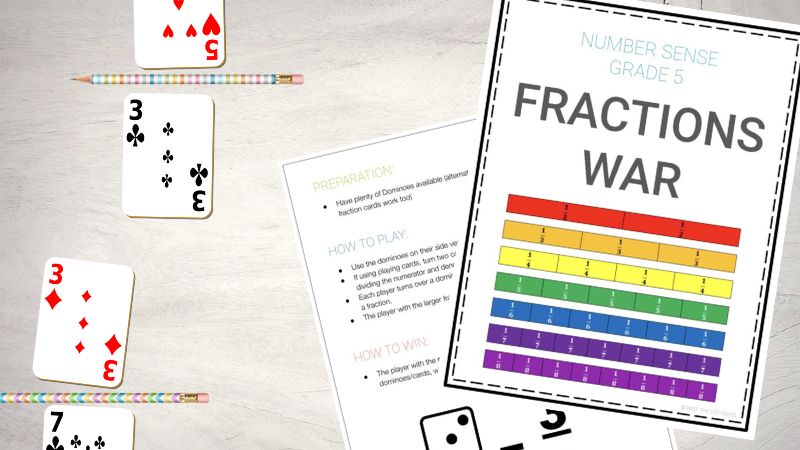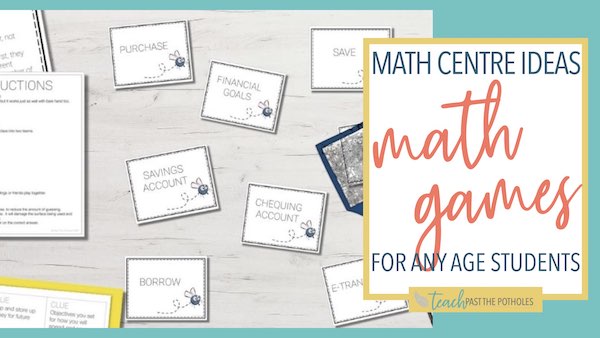Some links in this post may be affiliate links. If you click on them we may make a commission from qualifying purchases at absolutely no cost to you. Read our full Disclosure Policy here.
Why is teaching fractions so hard? Every year, kids groan when the topic is introduced. And let’s be honest, so do most adults! Fractions are challenging because they seem to defy most of the number concepts students have already learned. Why are there two ‘numbers’? How can a bigger number have a smaller value?
I actually love fractions, and algebra, two of the more widely dreaded areas of math! Over the years, I have figured out how to teach fractions so students actually UNDERSTAND the concepts of fractions, not just struggle to memorize procedures.
I love to see the change in their attitude toward the topic when they realize fractions really aren’t that foreign, and can even be fun!
What should students know before teaching fractions?
Fractions are, at the core, division. We have a fraction of something when one has been divided into smaller parts. If your students don’t have a solid understanding of basic division and multiplication concepts, start here. Take some time working on sharing problems and using arrays as a means of visualizing the process.

What is a simple way to explain fractions?
Students need to know that a fraction is a number between whole numbers (i.e., a part of a whole). You can explain that when we break something apart to share, we are sharing fractions of it.
Students actually have a fairly decent understanding of the basics of fractions without realizing it. They’ve already spent years sharing pizzas, cookies, toys etc… However, when we introduce fractional notation (how we read and write fractions) and procedures too early, they don’t connect the two. This is where confusion and frustration come in.

JOIN OUR VIP EMAIL GROUP
Get teaching tips, resources and freebies delivered to your inbox every week!
Essential Fractional Concepts Students Need to Understand
The denominator is NOT a number. I like to explain to students that the denominator isn’t a number but rather a label or name. For example, 2/4, the 4 doesn’t represent 4 of anything but rather ‘names’ or gives context to what the 2 represents (in this case fourths or quarters).
The 3 parts of a fraction together make one number. Students need to know not to read each part separately. As much as possible, model talking about fractions as one number. Say ‘three quarters’, not ‘three over four’.
There are two main types of fractions: fractions of a whole and fractions of a set. Be sure to use both types as examples in lessons.
How to Teach Fractions for Understanding
Fractions can be a difficult concept for students to grasp, but with the right strategies and approach, you can help them understand this important mathematical concept. Here are 7 tips for teaching fractions in a fun and effective way.
1. Teaching Fractions with Visuals
What is the easiest way to teach fractions? Visuals are a powerful tool for teaching fractions. Use pictures, diagrams, and models to help students see how fractions work. Use shapes to represent a whole and then divide it into parts to show how a fraction represents a portion of the whole. Use sets of objects and represent various parts – e.g., the number of red markers in a set of markers. Use number lines to find the position of a fraction.
2. Use Real-Life Fraction Examples
The best way to teach fractions is to root learning in student experiences and understanding of the world around them. Fractions are everywhere in our daily lives, and students will find them easier to understand if they see how they are used in real-world situations. Food examples such as pizza slices, and chocolate bars are commonly used but be sure to include other examples such as sets of everyday items, recipe measurements and even groups of people.
3. Make Fractions Hands-On with Manipulatives
Manipulatives should be front and centre when teaching fractions to kids. Fraction circles and fraction sets, Cuisenaire Rods and even Pattern Blocks are essential math manipulatives for fractions activities. However, mixing in less common objects such as blocks, legos, sets of toys and more can be a great way for students to see how fractions work. Have students use manipulatives to build their own models and understand how fractions can be combined to make a whole.

4. Focus on Problem-Solving, not Procedures
Teach fractions using word problems that require critical thinking and problem solving strategies to be used. Keeping fractions framed in context will help students develop a deeper understanding. This is so much more important than having them memorize steps.
5. Use Games and Activities to Practise Fraction Concepts
When teaching about fractions practice and repetition is necessary but it can get boring quickly! Games and hands-on activities can make learning about fractions fun and engaging.
There are many educational games available or you could create your own games, such as matching fraction cards or playing a fraction scavenger hunt, to help students learn about fractions in a creative way. Playing cards, fraction flash cards, dice and dominoes are great to have on hand. Don’t forget all the amazing digital tools available too!

READ THIS:
9 Math Games that are Perfect for Independent Math Centres
6. Emphasize Understanding, Not Memorization
In all fractions lessons and activities, it’s important for students to understand the concepts behind fractions, not just memorize rules and procedures. Don’t teach the traditional algorithms until students have had a chance to explore concepts and create their own strategies and meanings.
Encourage students to ask questions and encourage critical thinking. This will help them gain a deeper understanding of fractions and be better equipped to use them in real-life situations.
7. Provide Feedback and Encouragement
Finally, be sure to provide feedback and encouragement to your students. Immediate feedback is crucial in making sure students are learning and practising incorrect fraction concepts. Let them know when they are doing well and provide specific, constructive feedback when they make mistakes. Encouragement can go a long way in helping students feel confident and motivated to learn about fractions.
Ensure you are finding opportunities to work with small groups or individuals on specific strategies and skills. Math centres are the perfect time to work with guided math groups.
How do you teach fractions step by step?
1. Always begin with teaching the meaning of fractions: what they are, when we see them in real life and what they mean. DO NOT move on until students have this core understanding.
2. Next, introduce ways to represent fractions. Teach standard notation (numerator and denominator), words and relate these to models and drawings.
3. Once students have a solid grasp of representing fractions, it’s time to look at equivalent fraction. As with other fraction concepts, do not teach procedures such as multiplying numerator and denominator by the same number. Instead, focus on the meaning. Take a drawing or model and divide each piece again to show a new fraction. Combine pieces to make a new, simplified, fraction.
“Algorithms and procedures are only helpful when we understand why they work. Otherwise, they just lead to confusion!”
4. Now it’s time to teach comparing and ordering fractions. Students should be able to use a combination of their knowledge of representing fractions and finding equivalent fractions to achieve this.
5. Finally, if your grade standards require students to perform any operations with fractions, now is the time to build on the foundational knowledge and understanding they have built.

Would you like ready-to-use fractions resources?
You can find our fractions lessons, games, worksheets and assessments as part of our Number Sense units for grades 4-8 here.. Check them out in detail here.
How do you explain fractions to students? I’d love to know your best tips, games and strategies to get your kids to actually understand fractions! Share your ideas in the comments below!
Pin this post to save it for later!





Hi. I am impressed by this methods of teaching fractions, and I would love see more experience in teaching grade 3 progressively using the step by step with practical examples applicable to Grade 3 learners.